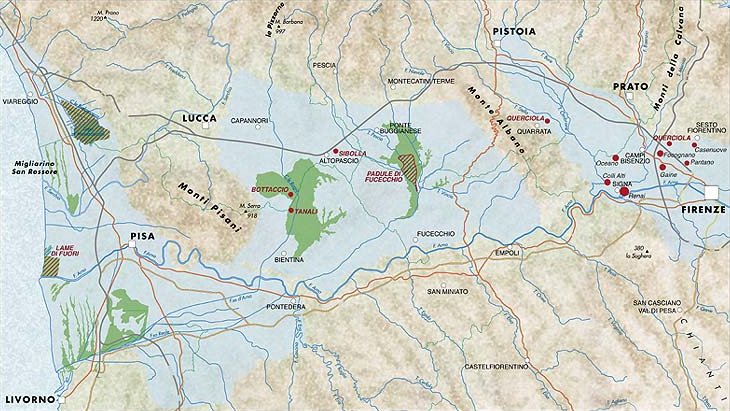The history of the marshes is mainly about their negation, revolving around a world where man has undertaken to change the habitat and model it more and more to suit his requirements.
The natural resources these areas have to offer have always attracted human communities since ancient times.
Over the centuries, man has altered the nature of the area to improve his standard of living but at the same time to guarantee continuity of resources which have proved so precious for the economy.
The Etruscans were among the first to begin extensive hydraulic engineering works.
These were later amplified by the Romans, who applied their own model of farming to large parts of the territory, mostly in the flatlands.
The decline of the Roman Empire and subsequent historical periods saw the interruption of the great reclamation works which were only taken up again, in dribs and drabs, in the Renaissance.
This does not mean that the marshes were totally abandoned in the Middle Ages.
On the contrary, they were an irreplaceable source of sustenance thanks to profitable activities like fishing, milling and navigation (the wetlands were an important navigable canal network) and other kinds of exploitation linked with the wetlands, e.g. hunting and grass gathering, which added to the family income.
The Middle Ages could be said to have seen the most "natural" type of settlement - the inhabitants did not change the characteristics of the territory, but rather adapted their activities to exploit what nature had to offer.
The rare efforts of partial reclamation of these times were followed by numerous, new interventions in the Medicean period.
These, however, could be defined as "contingent", i.e. their purpose was to stem precarious situations whenever they occurred: banks and canals were built, rivers diverted and land reclaimed, so creating extensive land holdings which were organised under the farming system of the time (e.g. the Fucecchio Marshes and Val di Chiana).
In the XVII century and in the first half of the XVIII century, the deteriorating conditions of hydraulic reclamation (i.e. the work necessary to drain and guarantee hygienic standards and productivity of the marsh and lands covered with stagnant water) led the new Governors, the Lorena, to undertake new interventions on a grand scale aimed at total reclamation.
This entailed a series of initiatives, not only drainage of the land to make it arable, but also the implementation of an infrastructure embracing a road network, settlements and other technical interventions which would allow economic and social growth of the territory.
And so began a process of alternating phases which continued into the following centuries, eventually leading to a mixed reclamation system based on canalisation and land filling techniques.
The aims today no longer favour agriculture but more the exploitation and conservation of the resources of the territory, including the wetlands themselves.




